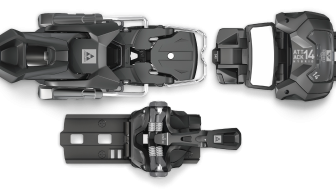Vancouver, B.C. Arc’teryx, veteran to mountaineering apparel, is venturing into new territory: hardgoods.
Early last week, they debuted their Voltair Avalanche Airbag and Procline boot in their Vancouver headquarters and then, later in the week, provided testing opportunities in the Callaghan Wilderness outside of Whistler Olympic Park. Both products will contribute to Arc’teryx’s biggest product launch yet in Fall 2016, which they say will be fivefold the size of previous years.
Although Arc’teryx is headed into new ground, they have plenty of experience to fall back on. “We took design elements from our shoes and bags and put them into our boot and airbag,” says Greg Grenzke, Arc’teryx Senior Designer. “They’re made with longevity in mind; we don’t want a new product every year.”
Voltair Avalanche Airbag
[metaslider id=10784]
“These are great ski packs,” says Peter Hill, Arc’teryx Senior Hardgoods Designer. “They just happen to have a balloon pop out of its head.” And a good ski pack it is, mostly thanks to its simplicity. Its two sizes (20L at 7.1 lbs. and 30L at 7.6 lbs.) both sport large main pockets with only a small, zipped upper pouch in it for storing goggles, small electronics and the like. A front pocket comes equipped with enough room for a shovel and a designated slot for a probe. And after three days in B.C.’s heavy, wet snow, the fully-taped zippers kept sandwiches, cameras and notepads fully dry.
Arc’teryx became seriously interested in avy bags about 10 years ago, but felt that the shortcomings of compressed gas—issues with reusability, travel legalities and size/weight restrictions—seriously inhibited design. In looking for an alternative, Arc’teryx engineers and industrial designers turned to centrifugal blowers around 2010, and roughly 20 propeller models later, had created a sufficient design to link to a lithium polymer battery, which works in temperatures as cold as -30°C. (When actively touring, the battery stays about 4° warmer due to body heat.)
While the battery’s weight, at 800g, can make for a heavy and pricey—it retails separately from the pack at $400—load, it’s intentionally designed to be large enough to last on multiple-day tours or in especially cold weather. Should users find it too heavy or cumbersome, the battery can be detached for a smaller option.
In testing the Voltair beyond its storage ability, the first noteworthy observation is that in can, in fact, be tested. Unlike the one-time usage of compressed air canisters, the Voltair’s electric operating system allows for as much testing as the battery can withstand; that’s about eight times when the bag is warmer than -30°C. It’s both reassuring and practical to be able to test the pack to decrease likelihood of user error.
The bright orange, 150L bag inflates in roughly five seconds and the trigger—located on the left shoulder and complete with a lock mode—is easy enough to yank down on while still skiing. After deploying, the Volatir releases a gust of air pressure every five seconds for a minute, should your bag get punctured and begin to deflate.
Packing the balloon back up to continue skiing is easy enough: turn the battery off (accessible via a small zip on the pack’s side) and stick the small, “deflator” tube into the designated spot on the left side of the bag and begin squeezing the air out. In a few minutes, you’ll be able to stuff—not roll—the bag back in its top compartment, zip the pocket and, after turning the battery back on, keep skiing.
It’s also worth noting the pack comes with a single leg strap, and while it’s comfortable enough to forget it’s even there, the strap serves the crucial purpose of keeping the pack properly fitted on the torso should the wearer be caught in a slide.
From a safety perspective, one of the more intriguing elements of the Voltair is its data collection capabilities. The bag’s digital control section—“the brain of the machine,” according to Senior Industrial Designer Gordon Rose—is programmed to record battery temperature and voltage, which, with user permission, can be utilized for product improvement and to better understand the conditions the bag is used in. Ideally, Arc’teryx hopes, this data can also be implemented for specific uses and to supplement weather stations.
The Voltair will be available for purchase in Fall 2016 . Pricing ranges from $1,650 (20L) to $2,000 (30L).










Does anyone have any experience traveling in the US or into/out of the US with a fan based avalanche pack? I asked Swiss Air about traveling with it and they said they do not allow it on flights into and out of the US, even packs like the voltair and jet force that do no use compressed air.
I never heard of any such regulations surrounding fan-based airbags. The only thing I can think of would be airplane rules surrounding lithium-ion batteries, which these packs use and which the FAA has stipulations surrounding carrying in checked luggage.